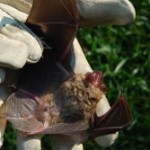“Ah, that’s one, ONE bat… two, TWO bats… three, THREE fabulous bats… Ah…Ah…Ah.” Many people grew up listening to Count von Count, Sesame Street’s beloved vampire, enthusiastically calculating the number of adorable bats flitting about above his head, but in reality one bat in a residential area is one too many.
Bats are intriguing animals that are an integral part of our ecosystem, but North Carolina bats in the attic, roof, or walls of your home can do more than drive you batty; they can transmit diseases that may harm your health or even cause death.
Potential Health Risks Associated With Bats
Rabies: Bats can transmit rabies, a virus that affects the nervous system of humans and other mammals that (when left untreated) can be fatal. A person who has been bitten by an infected bat or has contact with bat salvia is at risk of contracting rabies. According to the North Carolina Department of Health and Human Services (NCDHHS), people aren’t always aware that they’ve been bitten since bat bites are often painless and most encounters happen during people’s slumber. The NCDHHS warns that while only a small percentage of bats have rabies, “you never know which ones may be infected, so any physical contact with bats must be regarded as a potential exposure to rabies.” According to The Center For Disease Control and Prevention (CDC), once people begin to exhibit the symptoms of rabies, such as fever, confusion and hydrophobia (fear of water), the disease will inevitably lead to death. The CDC also reports that while human infection is rare, bats are the most common source of human rabies.
Histoplasmosis: Another risk associated with human contact with bats is the possibility of contracting Histoplasmosis, a disease caused by a fungus that grows in material exposed to bird or bat droppings. The disease, which primarily affects the lungs, is transmitted when people inhale spores from the fungus. When bats roost in a residential area, people are more likely to be exposed to soil or other material that has touched guano, or bat droppings, which increases the risk that they will contract the disease. According to MedlinePlus, the majority of people with acute pulmonary Histoplasmosis have no symptoms or they may experience mild symptoms such muscle aches and stiffness, fever, and chills. However, in some cases, the symptoms can be severe and may last for months, especially with individuals with suppressed immune systems. In rare cases, the disease infects the organs and can lead to death.
In 2012, bats invaded the walls of a Rockingham, North Carolina hospital, causing the facility to close temporarily while a professional bat removal service drove out the winged mammals. Fortunately, none of the patients or staff caught an illness from the bats, but people cannot be too vigilant when it comes to their health.
The reality of living with bat infestation extends beyond the danger of contracting an illness; the rancid odor that emanates from bat excrement can make home life intolerable and living with bats can cause damage to your property. These factors need to be examined, but awareness of potential harm is the most salient aspect of understanding the realities and dangers of living with bat infestation.
Resources:
http://www.nlm.nih.gov/medlineplus/ency/article/000098.htm
http://www.wwaytv3.com/2012/02/19/bat-infestation-closes-hospital


